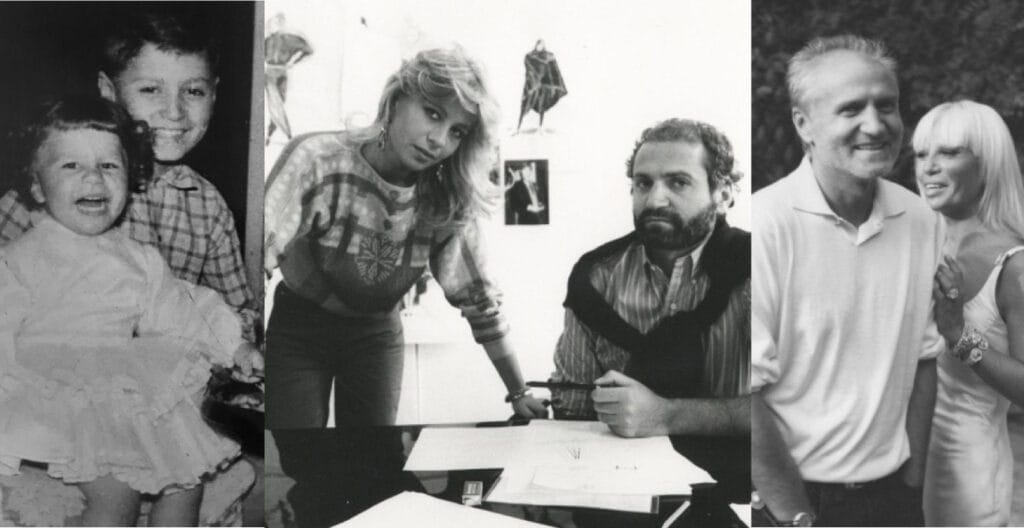In the glittering pantheon of luxury fashion, few names resonate with the same enduring allure as Versace. Synonymous with opulence, boldness, and daring designs, the brand has continuously shaped and redefined the fashion landscape since its inception. Founded in 1978 by Gianni Versace in Milan, Italy, Versace quickly ascended from being an emerging label to a symbol of exuberant glamour, a beacon for those who sought to encapsulate confidence and sophistication in their sartorial choices. The narrative of Versace is as much a tale of aesthetic innovation as it is of personal and familial vision, resilience, and tragic brilliance. This comprehensive exploration delves into the origins of Versace, the complexities of its ascent, its pivotal moments, and the rich legacy it continues to cultivate in contemporary fashion.

I. The Visionary: Gianni Versace and the Creation of a Legacy
The genesis of Versace lies in the audacious creativity of its founder, Gianni Versace, whose early fascination with fashion set the groundwork for the iconic brand. Born in Reggio Calabria in 1946, Gianni grew up surrounded by the world of sewing and craftsmanship, thanks to his mother, a dressmaker who operated her own business. This exposure to fabrics, tailoring, and design sparked his early interest in fashion, imbuing him with an acute understanding of the importance of both artistry and precision.
In his early 20s, Gianni moved to Milan, the pulsating heart of Italian fashion, where he honed his craft by working for several established fashion houses such as Genny, Callaghan, and Complice. It was here that Gianni’s innate ability to combine traditional craftsmanship with daring, provocative designs became evident. Drawing inspiration from the Greco-Roman classical world, Baroque art, pop culture, and modern technology, Gianni’s early collections were characterized by an eclectic fusion of historical and contemporary influences, yet remained undeniably original.
The official founding of Versace in 1978, with its first women’s ready-to-wear collection, signaled the arrival of a new force in high fashion. Gianni’s designs were a radical departure from the understated minimalism that had dominated the fashion scene in previous years. He embraced vivid colors, bold prints, and luxurious materials, often embellished with intricate details and provocative cuts that celebrated the female form. His audacity not only set him apart from his contemporaries but also earned him both critical acclaim and commercial success.
At the heart of Versace’s visual identity was the iconic Medusa head logo, symbolizing allure, beauty, and fatal attraction. According to Gianni, the Medusa was chosen because she could make people fall hopelessly in love with her, just as he intended his designs to captivate and seduce those who wore them.




II. Gianni Versace: Crafting a Distinct Aesthetic
The early success of Versace was built on Gianni’s ability to redefine the conventions of luxury fashion. His collections were unapologetically opulent, blending the richness of classical Italian design with modern provocations that reflected the cultural zeitgeist of the late 20th century. Gianni masterfully played with contrasts: traditional luxury fabrics such as silk and velvet were juxtaposed with avant-garde materials like metal mesh, leather, and latex. His pioneering work in fabric technology—particularly his use of metal mesh (Oroton), which draped fluidly over the body like liquid—became one of the brand’s most recognizable innovations.
Gianni’s designs also carried a potent sexual energy that was revolutionary at the time. The body-con silhouettes, revealing slits, plunging necklines, and sheer fabrics celebrated sensuality in a way that was both empowering and luxurious. The infamous “safety pin” dress worn by Elizabeth Hurley in 1994 exemplifies this ethos—a striking garment that combined high fashion with subversive elements, shocking audiences and securing Versace’s place in the fashion history books.
But Gianni’s genius was not confined to women’s fashion alone. He redefined menswear by rejecting the traditional codes of masculinity in favor of a more flamboyant, expressive style. His men’s collections were characterized by bold prints, vibrant colors, and luxurious fabrics that challenged the boundaries of what was traditionally considered “masculine” attire.
The early 1990s marked a golden era for Versace. Gianni’s designs were favored by some of the world’s most prominent figures, from Princess Diana to Madonna. His friendship with celebrities and his collaborations with artists such as Andy Warhol, Richard Avedon, and photographer Bruce Weber brought the brand into the cultural limelight. This merging of fashion with celebrity and art helped to solidify Versace’s reputation as more than just a fashion house—it became a cultural institution, one that blurred the lines between fashion, art, and popular culture.

III. The Versace Runway: Birth of the Supermodel and the Global Stage
One of the most defining contributions of Gianni Versace to the fashion world was his instrumental role in the creation of the “supermodel.” In the early 1990s, Gianni, recognizing the cultural power of these glamorous figures, began using a select group of models to personify the Versace woman. Naomi Campbell, Cindy Crawford, Linda Evangelista, Claudia Schiffer, and Christy Turlington became iconic muses for the brand, strutting down the runway in daring ensembles that exuded power, confidence, and sensuality. These women transcended the world of fashion and entered the realm of popular culture as stars in their own right, thanks in no small part to Versace’s casting.
The relationship between Versace and the supermodel reached its zenith with Gianni’s Spring/Summer 1991 runway show, where these models closed the show arm-in-arm, lip-syncing to George Michael’s “Freedom! ’90″—a moment that became legendary in fashion history. Gianni understood the importance of creating a spectacle and using the runway as a theatrical platform to communicate the drama, allure, and sensuality of his designs.
Versace’s appeal wasn’t limited to fashion insiders; it had become a global phenomenon. Gianni’s bold designs and his charisma as a public figure captured the attention of media across the world. He skillfully used his celebrity status and friendships with figures like Elton John, Madonna, and Princess Diana to position Versace as the ultimate expression of modern glamour.

IV. Tragedy and Transition: The Loss of Gianni and the Rise of Donatella
The course of Versace’s meteoric rise was abruptly altered on July 15, 1997, when Gianni Versace was tragically murdered outside his Miami Beach mansion by Andrew Cunanan. His death sent shockwaves throughout the fashion world, leaving behind not only a legacy of stunning creativity but also a family and business in mourning.
Following Gianni’s untimely death, his sister Donatella Versace, who had been a close collaborator and vice president of the brand, took the reins as creative director. Many speculated whether the brand could survive without its visionary founder, but Donatella proved herself to be a formidable leader, steering the brand into the 21st century while maintaining its core identity.
Donatella’s approach to design was in many ways a continuation of Gianni’s aesthetic philosophy, yet she added her own distinct touch. Where Gianni’s vision was often about excess and bold statements, Donatella sought to modernize the brand by infusing it with a sleeker, more contemporary edge. Under her leadership, Versace collections embraced a subtler, more streamlined approach to glamour, though the brand’s signature opulence and sensuality remained intact.


V. Versace in the 21st Century: Reinvention and Expansion
In the early 2000s, Versace faced several challenges, including financial instability and the pressure to remain relevant in an increasingly competitive fashion landscape. However, the brand, under Donatella’s direction, embarked on a period of reinvention and diversification that allowed it to regain its footing.
A key element of this transformation was the reinvigoration of Versace’s couture line, Atelier Versace. Donatella’s couture creations garnered acclaim for their craftsmanship and creativity, often gracing the red carpets of the world’s most prestigious events, worn by celebrities such as Lady Gaga, Jennifer Lopez, and Angelina Jolie. The brand’s couture offerings became synonymous with red-carpet glamour, once again positioning Versace as a leader in high fashion.
In addition to haute couture, Versace expanded its reach into various lifestyle sectors, including home furnishings, fragrances, and even luxury hotels. The brand’s Medusa logo and signature baroque prints became iconic symbols of status and luxury, recognizable in everything from bedding collections to homeware. This diversification allowed Versace to maintain its status as a global luxury powerhouse, even in the face of economic uncertainty.
VI. Versace and Pop Culture: Enduring Influence
Throughout its history, Versace has maintained a close relationship with the worlds of celebrity and pop culture, a connection that has only strengthened in recent years. In the age of social media and digital influence, the brand has continued to dominate the cultural conversation through its collaborations with artists, musicians, and social media influencers.
One of the most significant pop culture moments for Versace in recent years occurred in 2019 when Jennifer Lopez wore a recreation of her iconic green jungle-print dress from the 2000 Grammy Awards to close Versace’s Spring/Summer 2020 show. The original dress had famously “broken the internet” before that phrase was even coined, and the updated version proved that Versace’s designs still had the power to captivate a global audience.
Versace’s ability to continually tap into the zeitgeist while staying true to its heritage is a testament to its lasting relevance. The brand’s collaborations with contemporary artists like Kanye West, Migos, and Dua Lipa, as well as its presence in cultural phenomena like the television series The Assassination of Gianni Versace: American Crime Story, have helped to introduce Versace to new generations of consumers.


VII. Contemporary Collections: Modern Sensibilities and Timeless Glamour
In the present day, Versace remains one of the most celebrated fashion houses in the world. Its contemporary collections continue to reflect the brand’s core values of boldness, luxury, and sensuality while incorporating modern trends and innovations. Donatella Versace, now an industry veteran, has perfected the art of balancing the brand’s storied heritage with the demands of contemporary fashion.
Recent collections have seen Versace embrace more sustainable practices, responding to the growing demand for environmentally responsible fashion. The use of eco-friendly materials and ethical production methods is becoming increasingly important for luxury brands, and Versace is no exception. However, this shift towards sustainability has not come at the expense of the brand’s signature extravagance. The iconic motifs of Versace—bold prints, baroque flourishes, and figure-hugging silhouettes—remain as prevalent as ever, but with a modern twist that resonates with today’s fashion-forward clientele.
Versace’s current offerings also reflect a growing inclusivity in fashion, with the brand featuring a more diverse range of models in its campaigns and runway shows. This embrace of diversity, both in terms of ethnicity and body type, is a reflection of the changing landscape of the fashion industry, where inclusivity and representation are now paramount.
VIII. Versace and the Future: Innovating with Tradition
As Versace looks to the future, the brand is poised to continue its trajectory as a leader in the world of luxury fashion. Donatella Versace’s tenure as creative director has ensured that the brand remains relevant and exciting, while still honoring the legacy of her brother Gianni. Under her guidance, Versace has embraced new technologies, expanded its digital presence, and explored new ways of engaging with its audience.
The recent acquisition of Versace by Capri Holdings Limited in 2018 marked a new chapter in the brand’s history. The deal, valued at $2.1 billion, signaled the brand’s intention to expand its global reach and continue growing its presence in new markets. While the acquisition sparked concerns about the potential dilution of the brand’s identity, Donatella has remained adamant that Versace will stay true to its roots, continuing to create bold, luxurious designs that embody the spirit of the house.
The challenge for Versace, as for all luxury fashion brands, will be to navigate the delicate balance between innovation and tradition. In a rapidly evolving industry where trends come and go at breakneck speed, Versace’s ability to remain timeless yet contemporary will be crucial to its continued success.

The Future of Versace
From its inception in 1978 to its status as a global luxury powerhouse today, Versace has carved out an indelible place in the history of fashion. The brand’s fearless embrace of boldness, sensuality, and opulence, combined with its ability to adapt to changing cultural and social landscapes, has allowed it to maintain its relevance for over four decades. The vision of Gianni Versace, carried forward by Donatella, has transcended fashion to become a symbol of modern glamour, creativity, and individuality.
The story of Versace is one of resilience, innovation, and an unwavering commitment to excellence. As the brand continues to evolve, it will undoubtedly remain a cornerstone of the fashion world, shaping the future of luxury fashion while honoring the legacy of its legendary founder. Whether on the runway, the red carpet, or the streets, Versace remains a name that is synonymous with beauty, power, and timeless allure.






